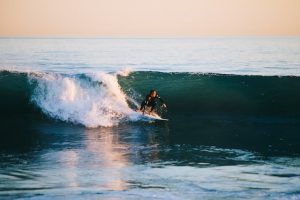Backside surfing is super fun. Although most surfers find frontside to be easier, the backside offers a challenge and an advantage. Riding the wave backside (with your back to the wave face) is more difficult because you can’t keep your eyes squarely on what the wave is doing behind you, so it takes more of both flexibility and calculation to stay in the sweet spot of the wave and pull off maneuvers. The advantage, however, is in the physical makeup of your body.
The pinpoint turning radius of backside surfing from your body’s range of motion makes for an exceptionally sharp bottom turn coupled with a vertical whip off the top. The first rule of backside surfing is to look ahead and predict what the wave will do pretty far down the line. This takes practice. But while beginners will learn to surf riding frontside, they will quickly pick up backside surfing. And the backside re-entry will be one of the earliest attempted maneuvers (behind the cutback). This is mainly due to the fact that a basic bounce off the top of the wave is bound to occur right after learning to pump down the line to get more speed. So let’s get started.
The Set Up
As you approach a vertical section, you should be looking ahead to predict how the wave will behave after your maneuver as that is important if you want to make the wave. As you glide into your backside bottom turn, make sure your arms are open with your eyes looking to the area on the wave you want to go to. Try to turn your upper torso towards the wave face as this will create the torque of your lower body following as you turn into your maneuver. With added pressure on your inside rail (heel side) and equal weight on both feet (remain centered over your board), begin your turn towards the top of the wave.
Just as you begin your turn and begin your climb, shift your weight to your back foot. The size of the wave is important here as you will quickly begin your top turn in small waves, but you may need to keep equal weight on your feet a little longer as you climb the face in bigger waves. The rule of thumb is that you can start your weight shift as soon as your nose is pointing towards the lip of the wave. And as you move up the wave face, you can now begin getting in position for the re-entry.
At this point, return your shoulders back to parallel with the surfboard and use your ankles and heels to flatten the bottom of the board to the wave face. Bend your knees to lower your body to lower your center of gravity. This will make your stance more solid on the board and allow you to weather the upcoming bank and drop into the trough.
For both bottom turn and re-entry, think of your back foot as a pivot about which your board will spin in a circle (like a sprinkler head). This will help you to visualize the maneuver.
The Backside Re-entry
Once you reach the lip (top of the wave), turn your shoulders and head back towards where you want to go next down the wave. Your hips and board will follow. Stay centered low over the stringer of the board, but be ready to flex and extend depending on the wave’s behavior.
At this point, there are several variations to the backside re-entry:
1. Hit the Lip
2. Under-the-lip Snap
3. Top Turn/ Speed Carve
4. Spinning Reverse
5. Tail Blow
Either decision you have to make, coming out of the maneuver means predicting what will happen next on the wave. And that shows the importance of looking ahead before you even begin this move. It’s all about planning, speed, and balance. Whatever happens, don’t give up.
The lip may hit your board with more power than you expected or the lip may come down over you as you come out of your turn. Either way, stay centered over your board with equal weight over both feet and try to ride it out.
Now, go give it a try. You know…Go Rip!



